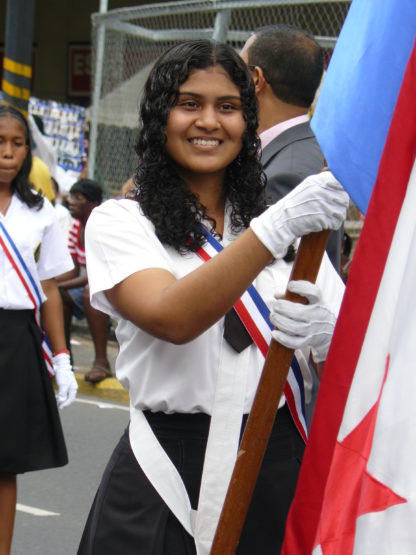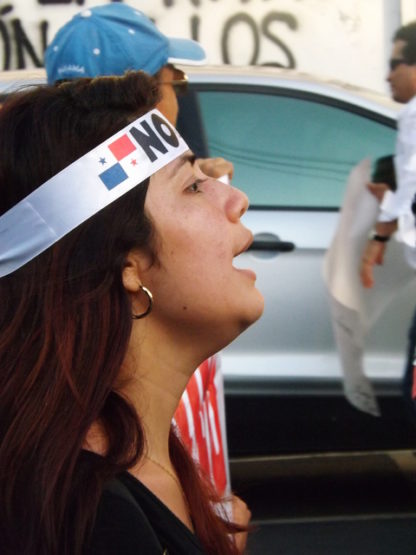
Flag Day, when Panama started to be a country of its own
by Eric Jackson
Intellectually lazy journalists and policy makers from the north, and the less scrupulous or less educated members of Panama’s aristocratic families, will refer to Panama as a Central American country. Did the US Southern Command use Panama as a control and jumping off point for Central America’s death squad wars of the late 70s and 80s, and did Panama lend a hand toward negotiating an end to those? Did Ernesto Pérez Balladares signal a new economic orientation for General Torrijos’s old party with his effusive praise for Honduras as an economic model for Panama to follow? Did Mireya Moscoso and the more provincial of the Panamñistas like the idea of themselves being banana republic oligarchs, just like in Central America? So Panama is a member of the Central American integration process, and our thuggish ex-presidents can claim a certain amount of immunity from prosecution for their crimes as members of the Central American Parliament. But Panama was never a member of the United Provinces of Central America. Under the Spanish crown, we were neither part of the Captaincy General of Guatemala nor the Viceroyalty of New Spain as the Central American Republics historically were.
Nope. Panama’s South American. We’re one of the Bolivarian Republics that rallied to the banner of The Great Liberator Simón Bolívar. Along with what are now Venezuela, Colombia and Ecuador we were part of Spain’s colonial Viceroyalty of New Granada and later Bolívar’s Gran Colombia.
Let’s not get into racism, into the supposition that the conquerors’ written language was the beginning of history. There is an older linguistic record here, notwithstanding centuries of efforts to erase it. The languages of most of our indigenous nations — the Guna, the Ngabe, the Bugle, the Naso and the BriBri — are of the Chibchan family of languages, which as best we know trace roots to the central plateau of what is now Colombia. Our other two indigenous nations, the Embera and the Wounaan, are historically known to come from the Pacific lowland jungles of what is now Colombia. There are suggestions that these latter two peoples’s ancestors made their way there from the Amazon basin. Leave it to DNA research and archaeology to modify these genesis and exodus tales, but for now it’s reasonably safe to say that all of Panamas’ pre-Columbian roots are also South American. The place was already an important crossroads when the Spaniards got here and the people knew of the Aztec and Maya civilizations to the north and west, and of Incas and Aymara of the Andes, as well as the circum-Caribbean trade and cultural zone which largely also traced roots to South America, to the Orinoco Valley from whence the Tainos and Caribs are thought to have come. We were South American then, if still the route by which Mexican corn got to the southern continent and Bolivian hot peppers became part of Caribbean island culture.
Come 1903, were both the native and Spanish histories to be overlain with a North American definition? Separation from Colombia was, after all, mainly a foreign project. See, a moribund but still existent French company had this concession from Colombia to build a canal, which was set to expire on December 31, 1903. Once that happened the Americans, who were interested in taking over the canal project, would have no reason to buy out the French company’s stake. Perhaps most of the shareholders in the French company were in France, where Panama had also become a synonym for a financial boondoggle, but the dominant active parties were the Panama Railroad Company, a New York corporation represented by the Wall Street law firm of Sullivan & Cromwell. The railroad had hauled away dirt and rock excavated by the French companies’ effort and took shares as part of their compensation. They looked forward to a similar and more profitable relationship with an American effort to finish the canal. Yes, they got Teddy Roosevelt interested and yes, they convinced war-weary Panamanians that it was a good idea, but the conspiracy that hatched our separation from Colombian came out of the railroad company, its law firm and a clique of friends from the Conservative Party that held sway in Panama City at the time. For appearances they brought in a dissident Liberal or two, but this was a corporate / Conservative plot with US backing.
The great liberator chosen for Panama was the railroad company’s physician, Dr. Manuel Amador Guerrero. The details were mostly left to an engineer for and shareholder in the French company, Philippe-Jean Bunau-Varilla, and New York attorney William Nelson Cromwell. A revolution kit was provided for Amador Guerrero, complete with a declaration of independence apparently drafted in the offices of Sullivan & Cromwell and a proposed Panamanian flag designed by Mrs. Bunau-Varilla. Amador Guerrero’s talent was in medicine and his passion was for gambling but politically maladroit as he may have been, a flag and declaration of independence putting the imprint of the United States on the new republic were things that he knew to be inappropriate, things that would cause him problems with all of the rest of Latin America. So he ditched the Sullivan & Cromwell declaration and handed the task of writing a more suitable declaration to a committee whose leading light was dissident Liberal Carlos A. Mendoza and he handed the job of designing a new flag to his son, Manuel Encarnación Amador. The younger Amador, a man of his times, was not one to sew things even if he was a competent draftsman, so he made a sketch and in turn handed the project over to his mother, María de la Ossa de Amador. She ran this underground women’s committee to procure the material and produce enough of these flags to get them on the streets of the capital once the coup had begun. So on its second day, November 4, 1903, the Republic of Panama had a flag.

~ ~ ~
These announcements are interactive. Click on them for more information.










